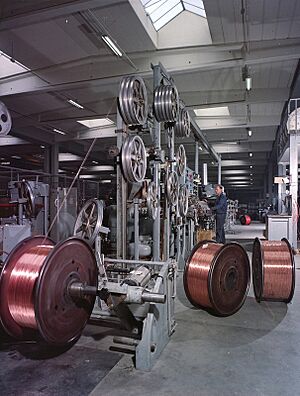Standard Telephones and Cables facts for kids
 |
|
| Public | |
| Industry | Telecommunications |
| Fate | Acquired |
| Successor | Nortel |
| Founded | 1925 |
| Defunct | 1991 |
| Headquarters | London, UK |
|
Key people
|
Sir Kenneth Corfield (chairman) |
Standard Telephones and Cables Ltd (later known as STC plc) was a British company. It made equipment for phones, telegraphs, radio, and other communication systems. STC created many important new technologies. These included pulse-code modulation (PCM) and optical fibres, which are used in modern internet cables.
The company started in London in 1883. It was first called International Western Electric. It was part of an American company called Western Electric. In 1925, Western Electric sold its international parts. International Western Electric was bought by International Telephone and Telegraph (ITT). This sale helped Western Electric avoid problems with the American government. In 1982, STC became its own company. It was listed on the London Stock Exchange. Later, in 1991, a company called Nortel bought STC.
Contents
How Did STC Begin?
The company began in 1883. It sold telephones and exchange systems from Western Electric. These products were designed in the USA. Importing them was expensive. So, in 1898, the company bought a factory in North Woolwich, London.
This factory started making electrical cables. It also put together equipment using parts from Belgium and the USA. Soon, the factory began making its own parts too. In 1910, the company officially became a British business.
World War I (1914-1918) stopped the company's growth for a while. STC helped with the war effort. They provided communication tools for the military. This included cables and wireless technology. After the war, radio technology grew fast in the USA. STC used this to help set up the British Broadcasting Company (BBC) in 1922. They made radio receivers and used new electron tube technology.
Growing Between the Wars
In 1925, Western Electric sold its international businesses. The buyer was a new company called ITT Corporation. ITT was known for being very active and innovative. ITT renamed its new UK company Standard Telephones and Cables. The name suggested high quality and a standard for others to follow.
In 1933, a company called Brimar was started. It made American-style electron tubes. These were made in Foots Cray, near another factory.
In just a few years, STC made many advances. They developed multi-channel transmission in 1932. Microwave transmission came in 1934. Coaxial cabling was developed in 1936. STC also built the entire radio systems for famous ships like the Queen Mary and Queen Elizabeth. In 1938, they patented pulse-code modulation. This was a very important time for phone technology.
Between 1939 and 1945, STC did important work for the military during World War II. They made many improvements for aerial warfare. This included better communications, radar, and navigational aids. A special system called OBOE was also developed.
The Rise of Modern Telecommunications

The 1950s saw the start of television broadcasting. STC made many technical breakthroughs. They helped cover the Queen Elizabeth II's Coronation in 1953. As TV spread across Britain, it often used STC's technology and equipment.
STC also improved communications for ships and planes. Their products made ship-to-ship, ship-to-shore, and civil aviation communications more modern. Over time, STC made it possible to have phone calls under the sea. They became a major player in this field. Their production unit in Southampton opened in 1956. STC became a world leader in undersea cables after buying Submarine Cables Ltd in 1970.
In the late 1940s and early 1950s, STC also supplied equipment for British Railways. They provided systems to control train signals. This included route setting panels for points and signals. These systems used technology similar to phone exchanges.
Digital technology started to replace analogue systems. This happened after Bell's invention of transistors. STC's first PCM link in 1964 was a big step. It took almost 30 years for the right materials to be ready for it to work.
Entering the Digital Age
In 1966, Charles Kao from STC showed something amazing. He proved that light could carry speech and data very fast and accurately. This was the idea behind fibre optics. Again, it took time for the right materials to be developed. But by 1977, a commercial fibre optic link was installed in England. Within ten years, BT (British Telecom) started using fibre optic cables instead of metal ones. STC's factory in Newport became very important for updating the UK's public phone system.
STC was also a key player in phone switching equipment. In 1971, the company installed a fully digital phone exchange in Moorgate, London. This exchange switched PCM signals between other exchanges. Until 1980, STC's TXE4 analogue electronic switch was used to replace older systems. STC, along with other companies, developed the fully digital System X switch. This system was still in use in the UK in 2005.
Why Did STC Decline?
ITT Corporation needed money for its new phone switching system. So, between 1979 and 1982, ITT sold most of its shares in STC.
In the late 1980s, people talked a lot about "convergence". This meant combining computers and telecoms. STC tried to enter the mainframe computer market. They took over ICL. But this caused financial problems for STC. The idea of combining computing and telecoms was good, but it was too early.
By 1991, STC faced many challenges. They had an older workforce. They lost business from the newly privatised BT. Their production was spread across too many expensive locations. There was no clear leader to take over from their former chairman, Sir Kenneth Corfield. Because of these issues, the Canadian company Northern Telecom (Nortel) bought STC.
Where Did STC Operate?
STC was mainly based in the United Kingdom. But it also had operations in Australia. The Australian part of the company was bought by Alcatel Australia in 1987.
|

